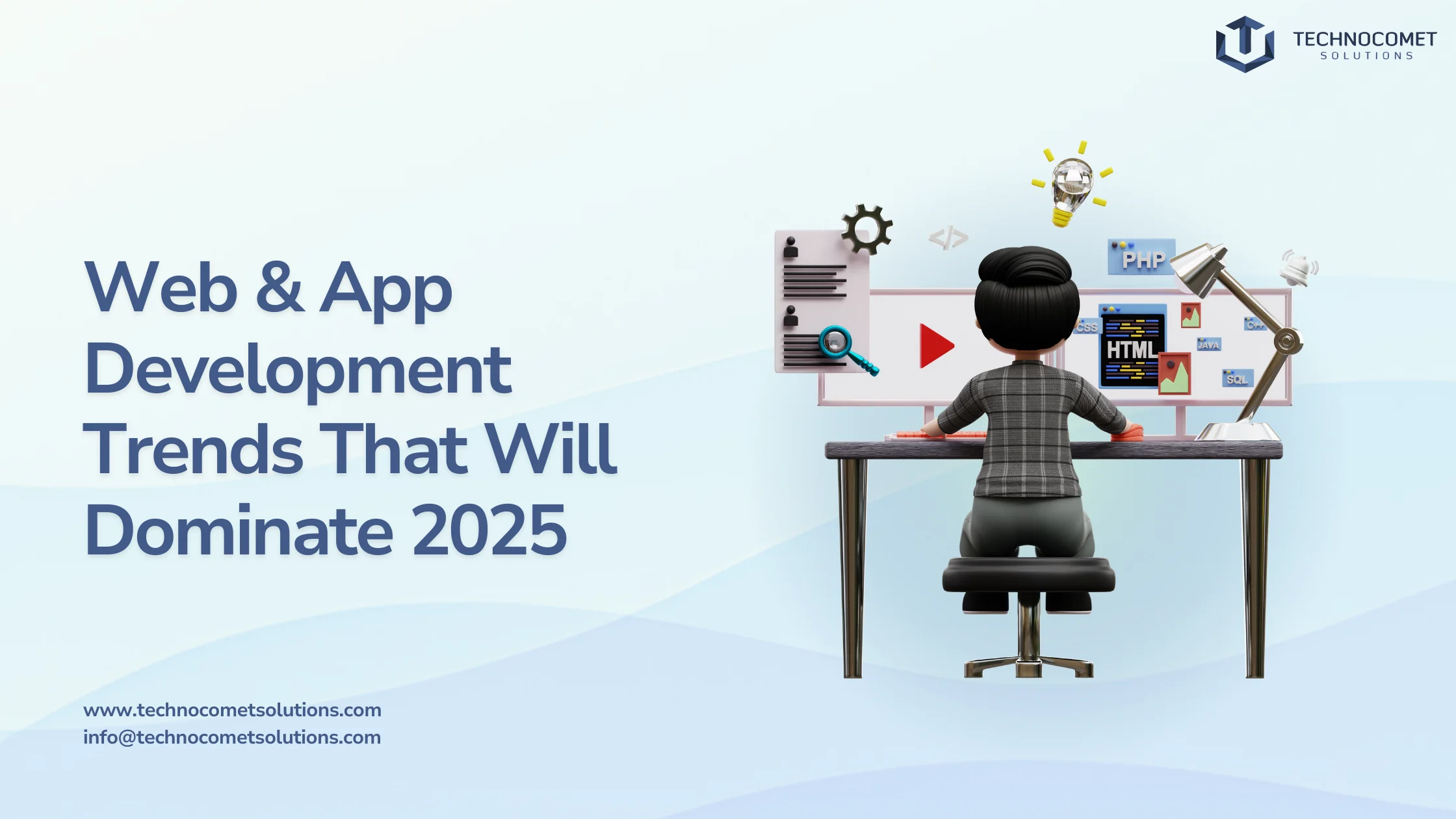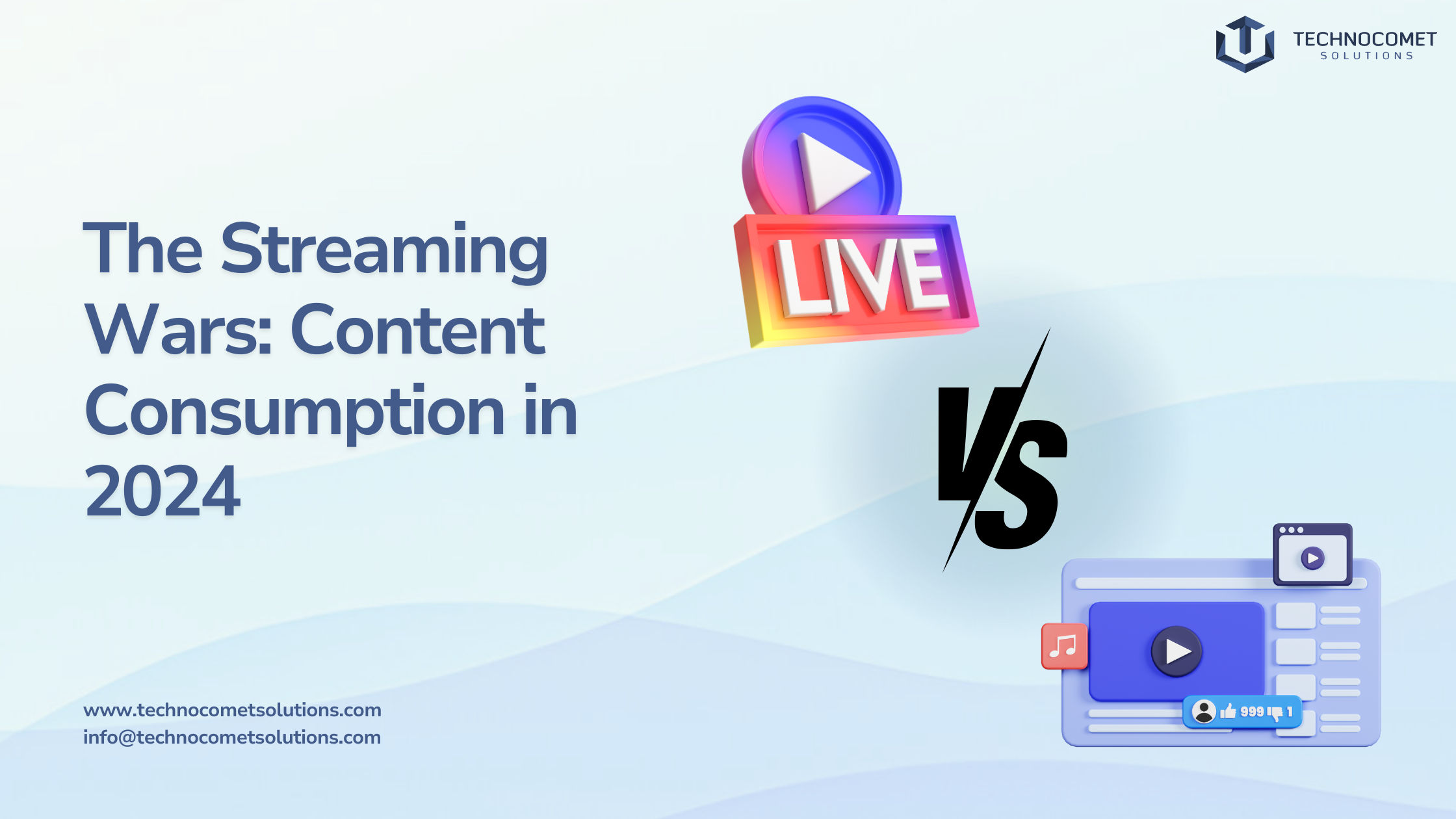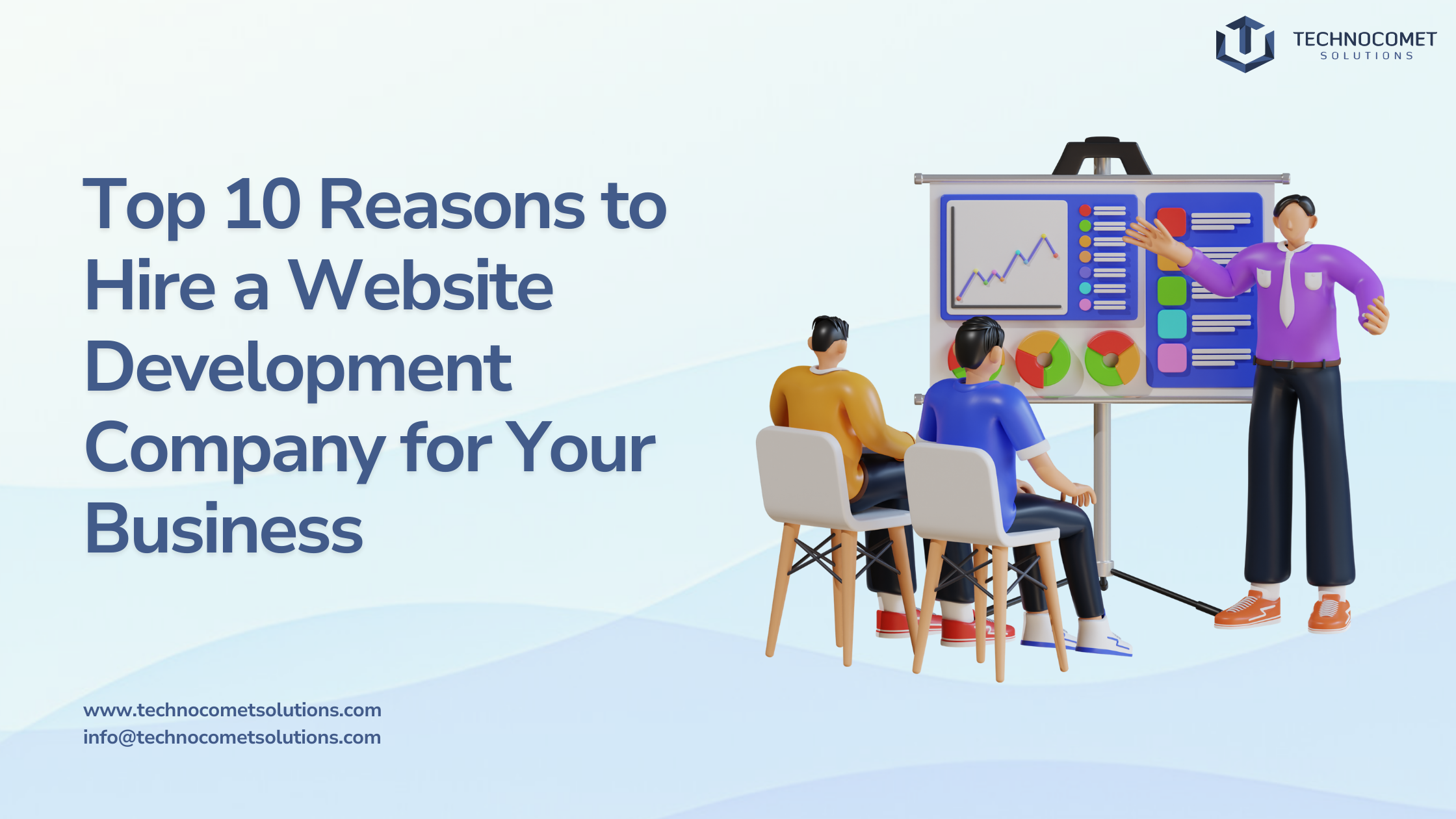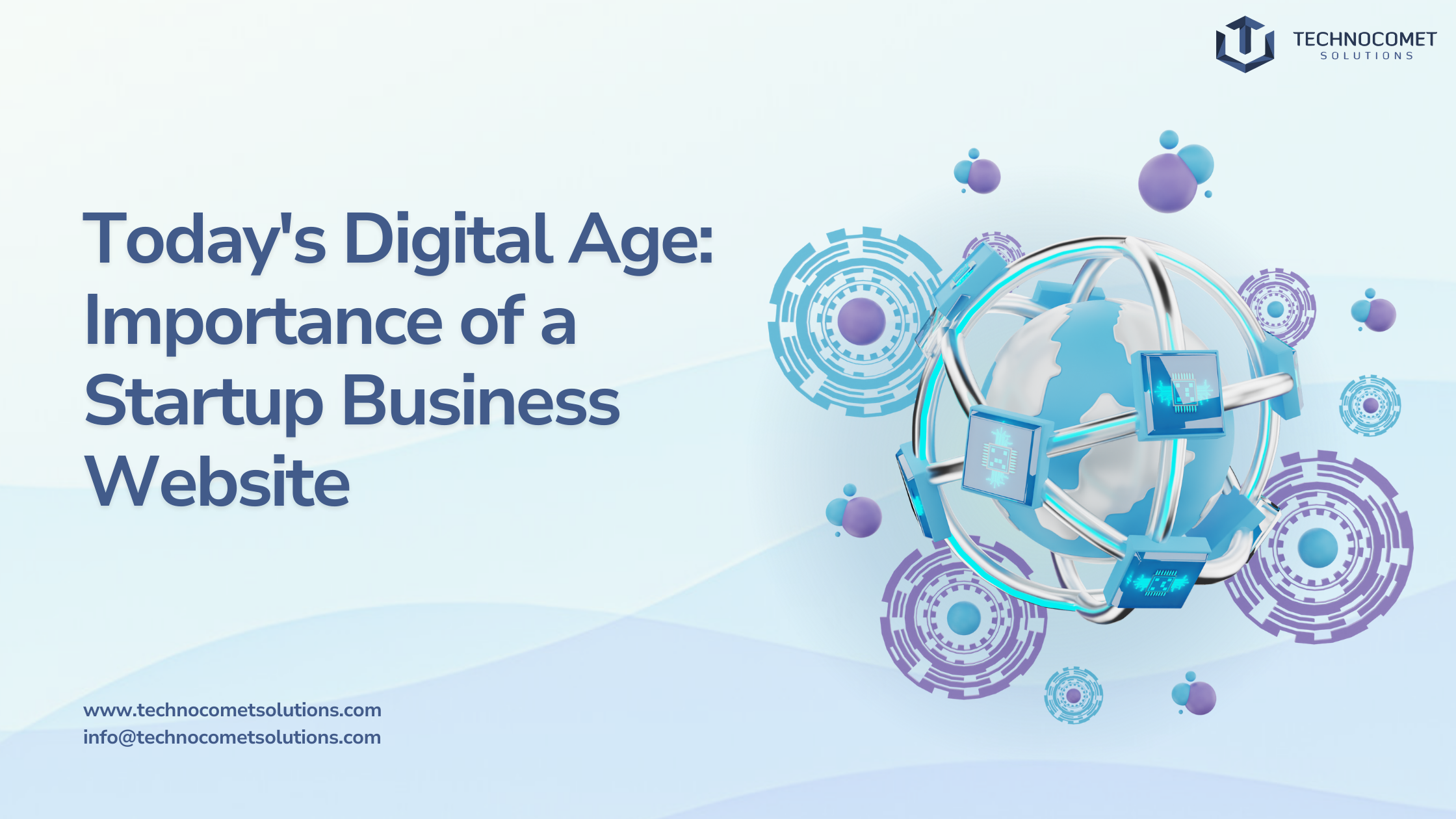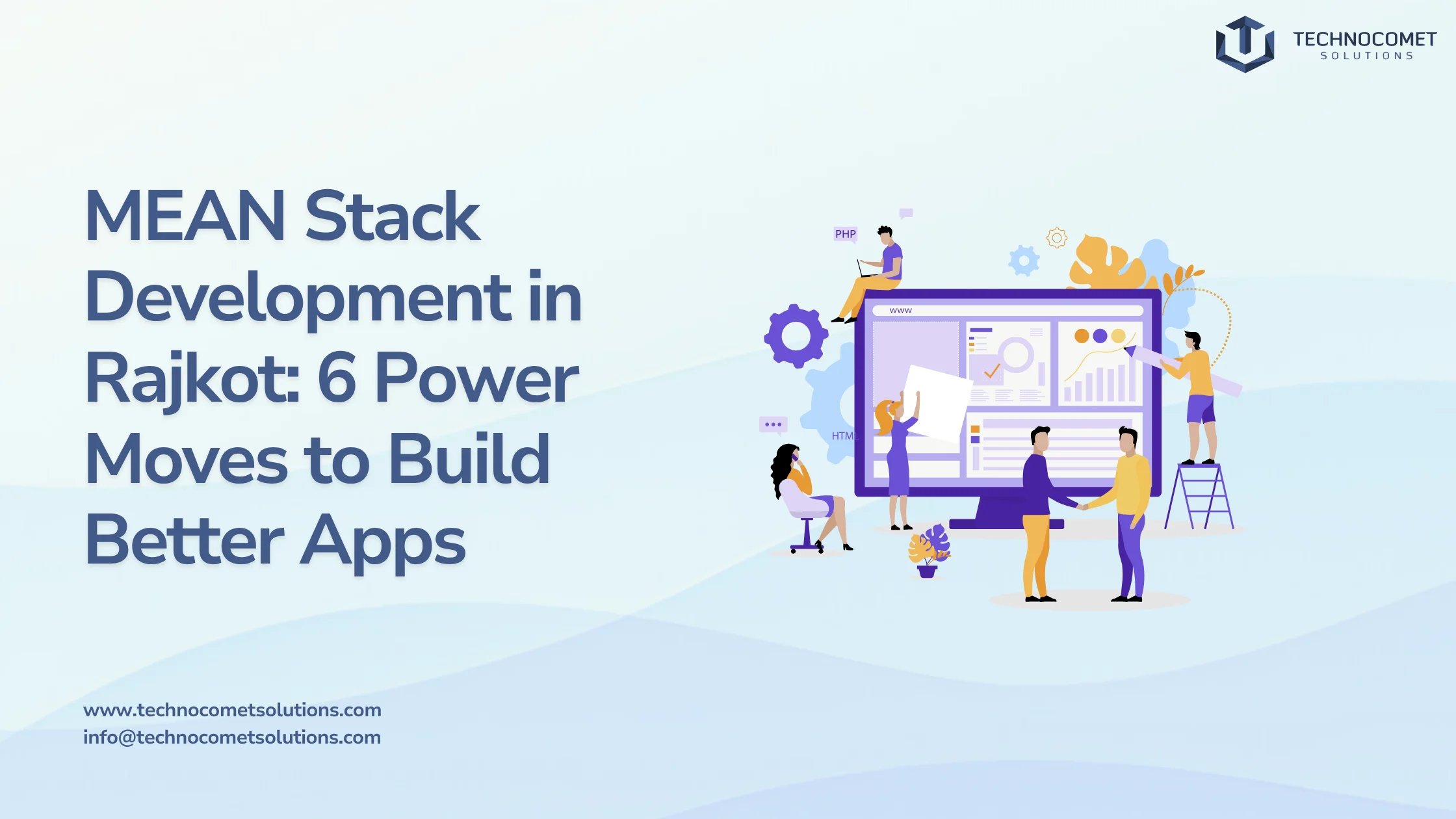Introduction
The landscape of web and app development is evolving rapidly, driven by advancements in technology and shifting user expectations. As we step into 2025, staying updated with emerging trends is critical for businesses and developers to remain competitive. Progressive web apps (PWAs), for instance, are transforming the user experience by combining the speed of web apps with the functionality of native apps. With their offline capabilities and superior performance, PWAs are becoming indispensable for businesses aiming to enhance user engagement. Similarly, the integration of artificial intelligence (AI) and machine learning (ML) is revolutionizing applications by enabling personalized experiences and predictive capabilities. Recognizing the growing importance of cybersecurity, Technocomet Solution adopts cutting-edge practices to ensure robust data protection across its projects, offering clients peace of mind in an increasingly digital world.
By embracing these trends and technologies, businesses can stay ahead of the curve. Partnering with a forward-thinking development company ensures your applications meet evolving user needs while maintaining a competitive edge in the market.
The Rapid Evolution of web and app Technologies
Over the past few years, we have witnessed a significant transformation in web and app development technologies. Innovations such as artificial intelligence (AI), machine learning (ML), and progressive web apps (PWAs) are redefining how applications are built and experienced. These technologies not only enhance functionality but also improve user engagement, making it essential for developers to adapt swiftly to these changes. For instance, frameworks like React and Vue.js have revolutionized front-end development, enabling developers to create dynamic user interfaces with ease.
Meanwhile, back-end technologies like Node.js and serverless architectures are streamlining server management, allowing developers to focus on building features rather than infrastructure. As these technologies continue to evolve, they will play a crucial role in shaping the future landscape of web and app development.
Why Staying Updated with Trends is Crucial for Businesses and Developers
In a fast-paced digital world, businesses must keep pace with technological advancements to meet consumer demands. Staying updated with trends in web and app development allows companies to leverage new tools and methodologies that can enhance their products’ performance and user experience. This adaptability can lead to increased customer satisfaction, retention, and ultimately, revenue growth. Moreover, being aware of industry trends helps businesses identify opportunities for innovation and differentiation in a crowded market.
For developers, understanding these trends is essential for career growth; it enables them to enhance their skill sets and stay relevant in a competitive job market. As technology continues to advance at an unprecedented rate, proactive engagement with these trends becomes a vital strategy for long-term success.
An Overview of the Emerging Trends Shaping 2025
As we look ahead to 2025, several key trends are poised to shape the landscape of web and app development. AI and machine learning integration will continue to advance, offering deeper insights into user behavior and preferences, enabling businesses to deliver highly personalized experiences. Progressive Web Apps (PWAs) are expected to gain traction as they offer a native app-like experience through the web, making them a preferred choice for businesses. Additionally, voice and gesture-driven interfaces are likely to grow in popularity, providing users with more intuitive and seamless ways to interact with technology. The rollout of 5G networks will further revolutionize user expectations, delivering unparalleled speed and connectivity that will redefine the boundaries of digital experiences. Enhanced security measures will become critical as businesses work to counter rising cyber threats and safeguard user data.
Sustainability in development is also emerging as a priority, with developers adopting eco-friendly practices to reduce environmental impact. Meanwhile, augmented reality (AR) and virtual reality (VR) are set to expand their presence across industries, offering immersive experiences that captivate and engage users. By understanding these trends, businesses can strategically adapt to evolving consumer demands, and developers can innovate, creating solutions that are not only cutting-edge but also resonate with the priorities of the modern world.
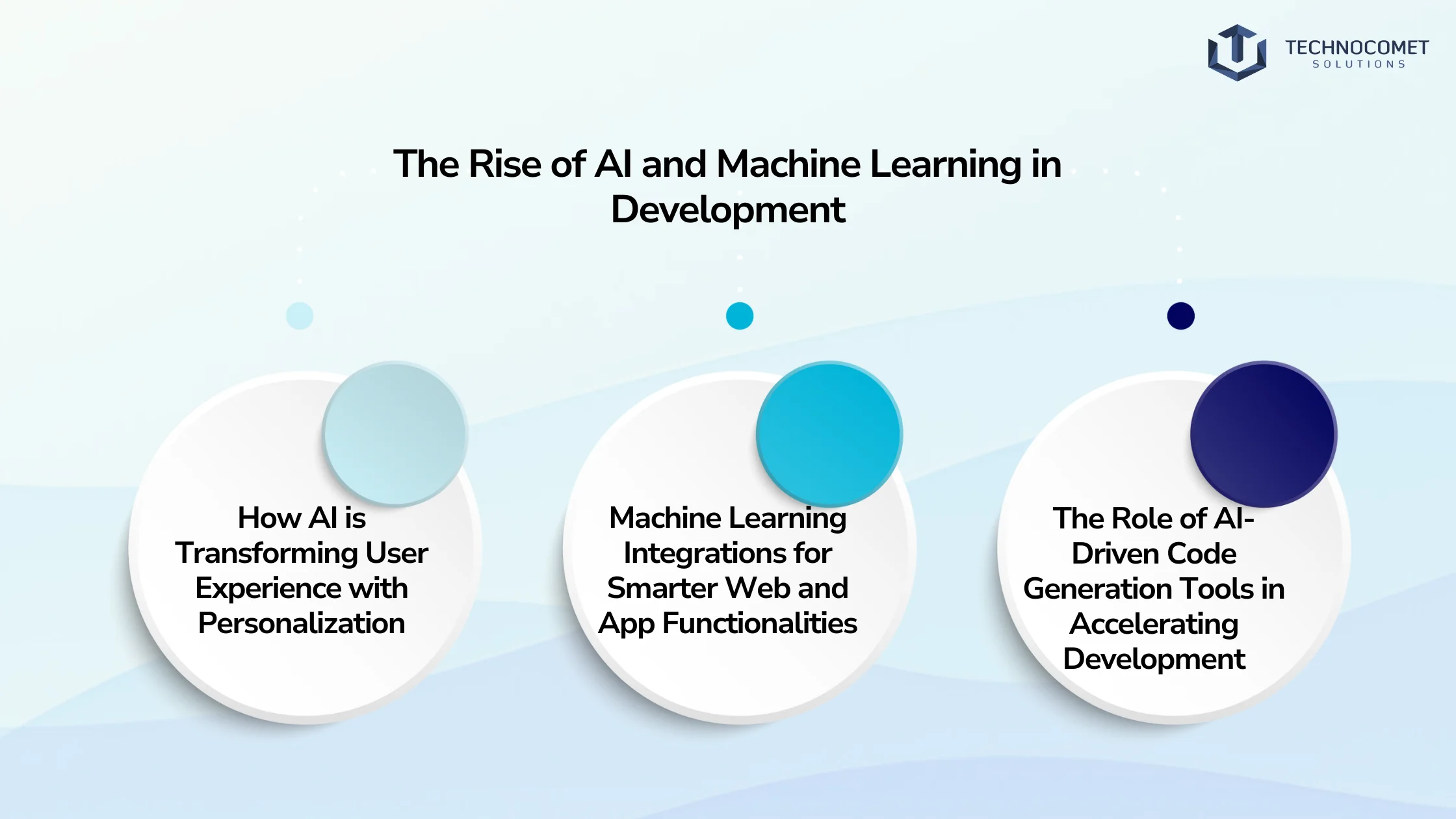
The Rise of AI and Machine Learning in Development
How AI is Transforming User Experience with Personalization
AI is revolutionizing the user experience by enabling hyperpersonalization in applications. By analyzing user behavior and preferences through data analytics, AI can tailor content and features to meet individual needs, leading to a more engaging experience. For instance, e-commerce platforms can recommend products based on previous purchases or browsing history, enhancing user satisfaction significantly. Furthermore, AI-driven chatbots provide real-time assistance, improving customer service while reducing operational costs for businesses.we
As users become accustomed to personalized experiences across platforms like Netflix or Spotify, they expect similar levels of customization from all applications they interact with. This shift towards personalization not only enhances user engagement but also fosters loyalty among consumers who feel valued by brands that understand their preferences.
Machine Learning Integrations for Smarter Web and App Functionalities
Machine learning allows developers to create smarter applications that can learn from user interactions over time. This capability enables features like predictive text, smart search suggestions, and automated customer support through chatbots, making applications more intuitive and user-friendly. For example, platforms like Google Photos use machine learning algorithms for image recognition, allowing users to search for photos using keywords related to people or objects within them.
Additionally, machine learning can enhance security measures by identifying unusual patterns in user behavior that may indicate fraudulent activity or security breaches. By continuously improving based on user feedback and data analysis, machine learning ensures that applications remain relevant and responsive to changing user needs.
The Role of AI-Driven Code Generation Tools in Accelerating Development
AI-driven code generation tools are streamlining the development process by automating repetitive tasks and suggesting code snippets based on context. Tools like GitHub Copilot assist developers by predicting code lines as they type, which not only speeds up the development cycle but also reduces errors that can occur during manual coding processes. This automation allows developers to focus on more complex aspects of application design while ensuring that best practices are followed consistently throughout the codebase.
As these tools continue to improve through machine learning techniques, they will become indispensable assets in the toolkit of modern developers. Moreover, by reducing the time spent on routine coding tasks, teams can allocate more resources towards innovation and creative problem-solving.
Progressive Web Apps (PWAs): The Future of Accessibility
Why PWAs are Gaining Traction Among Businesses
Progressive Web Apps combine the best features of web pages and mobile applications, making them increasingly popular among businesses looking to enhance their digital presence without incurring high development costs associated with native apps. PWAs offer a seamless experience across devices without requiring users to download an app from an app store; they can be accessed directly through a web browser.
This ease of access is particularly appealing for businesses aiming to reach a wider audience quickly while maintaining high engagement levels. Additionally, PWAs often result in lower bounce rates since users can interact with content immediately without waiting for downloads or installations.
Key Advantages of PWAs: Speed, Offline Access, and Cross-Platform Compatibility
Progressive Web Apps (PWAs) bring a range of benefits that make them highly appealing for businesses aiming to enhance user experiences. One of the standout advantages of PWAs is their speed. By leveraging caching techniques, they enable users to access content almost instantly, reducing loading times significantly. Another key feature is offline access, made possible by service workers that cache resources locally. This functionality ensures users can interact with content even without an active internet connection, offering a seamless experience. Additionally, PWAs boast cross-platform compatibility, working effortlessly on any device with a web browser, whether desktop or mobile. This eliminates the need for separate development efforts for different platforms, reducing costs and simplifying maintenance.
These advantages not only improve user experiences but also drive higher conversion rates for businesses adopting PWAs. Moreover, PWAs require significantly less storage space compared to traditional apps, making them more attractive to users who value efficient use of device resources. This combination of convenience, performance, and compatibility ensures that PWAs remain a powerful tool for businesses looking to stay ahead in the competitive digital landscape.
Successful Examples of PWAs and What We Can Learn from Them
Companies like Twitter Lite and Starbucks have successfully implemented PWAs, resulting in increased engagement and improved conversion rates. Twitter Lite saw a 75% increase in tweets sent per session after launching its PWA. Starbucks’ PWA allows customers to browse the menu offline and place orders seamlessly across devices without needing an app download; this has led to higher sales during peak times when mobile app performance might lag due to high traffic volumes.
Their success demonstrates the potential of PWAs in enhancing user experience while reducing operational costs. By analyzing these case studies, other businesses can glean valuable insights into best practices for implementing their own PWAs effectively.
Voice and Gesture-Driven Interfaces
The Increasing Demand for Voice-Command-Enabled Apps
With the rise of smart speakers like Amazon Echo and Google Home as well as voice assistants such as Siri or Google Assistant, there is a growing demand for voice-command-enabled applications across various sectors, from healthcare apps providing hands-free information retrieval during medical procedures to home automation systems allowing users greater control over their environment through simple voice commands.
This trend reflects a broader shift towards hands-free technology that prioritizes convenience and accessibility.
Gesture-Driven Design: A Natural Evolution in User Interaction
Gesture-driven interfaces are becoming more prevalent as touchless technology advances; this design approach allows users to navigate applications using gestures rather than traditional input methods such as clicking or tapping screens, like swiping left or right on dating apps or using hand movements recognized by cameras installed in smart TVs or gaming consoles like Microsoft’s Kinect system.
Such interfaces create a more immersive experience that feels natural for users accustomed to interacting with their environments through gestures rather than buttons.
Tools and Technologies Enabling Seamless Voice and Gesture Integration
Developers can leverage tools like Google Assistant SDK or Apple’s SiriKit to easily integrate voice commands into their applications; similarly, gesture recognition technologies such as Leap Motion or Intel RealSense enable developers to create more interactive experiences without physical touch. This opens up exciting possibilities for industries ranging from gaming entertainment all the way to healthcare, where hands-free operation may be necessary during surgical procedures.
As these technologies continue evolving rapidly alongside consumer demand innovations emerge frequently enhancing overall quality life experiences available today.
Enhanced Security Measures in Development
The Growing Importance of Cybersecurity in a Connected World
As cyber threats become more sophisticated, with ransomware attacks targeting large corporations making headlines daily, the importance of cybersecurity within web and app development cannot be overstated. Developers must prioritize security measures to proactively protect user data from breaches while building trust among customers who increasingly value privacy regarding personal information shared online. Incorporating multi-factor authentication (MFA) and encryption protocols has become a standard practice in safeguarding sensitive data.
Additionally, regular vulnerability assessments ensure applications remain resilient against evolving cyber threats. By emphasizing robust security practices, businesses can maintain user confidence and strengthen their position in the competitive world of web and app development.
Leveraging Blockchain for Secure web and app Development
Blockchain technology offers a decentralized approach to data security, making it difficult for unauthorized parties to access sensitive information. Implementing blockchain solutions enhances trust among users regarding data privacy while providing transparency and audit trails for transactions conducted within applications. This is particularly relevant in financial services, where regulatory compliance mandates stringent security protocols to protect client assets against fraud.
Beyond finance, industries like healthcare are leveraging blockchain to secure patient records and ensure tamper-proof data management. The integration of blockchain technology highlights its transformative potential for achieving unparalleled security in web and app development.
Adopting Zero-Trust Architecture to Protect User Data
Zero-trust architecture requires verification at every stage of access, ensuring only authorized users can view sensitive information. This approach significantly reduces the risk of data breaches within applications by treating every request, whether internal or external, as potentially harmful until proven otherwise. Adopting zero-trust principles strengthens the overall security posture while fostering a culture of accountability among teams responsible for maintaining application integrity.
Automated monitoring tools that detect anomalies in real-time further enhance the effectiveness of this model. As cyber threats evolve, zero-trust architecture is becoming an indispensable framework in secure web and app development.
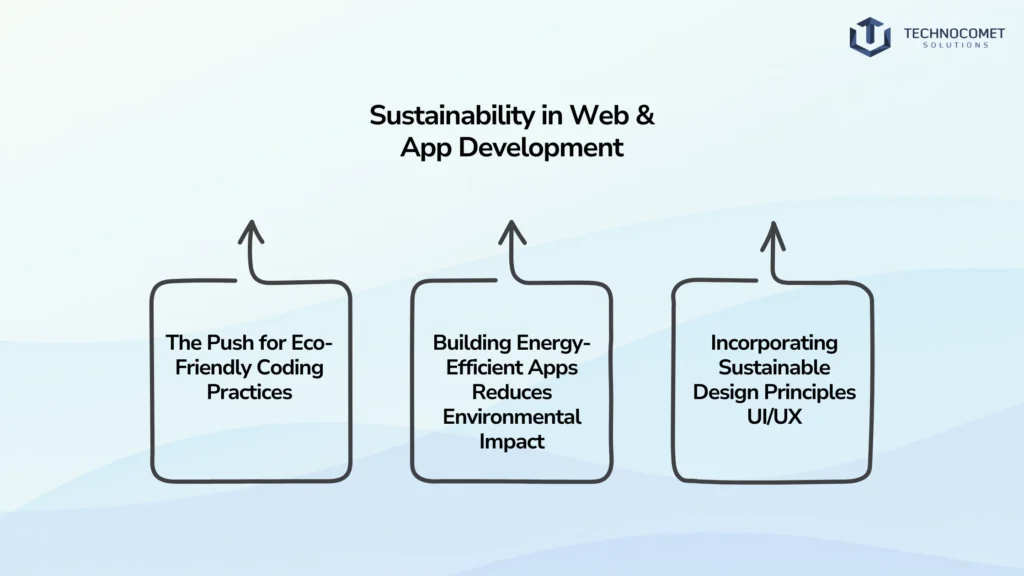
5G’s Impact on web and app Development
How 5G is Reshaping User Expectations for Speed Performance
The rollout of 5G technology is setting new standards for speed and performance within web and app development; users now expect instantaneous loading times and seamless interactions across devicesa shift necessitating developers to optimize applications accordingly to ensure they meet heightened expectations regarding responsiveness and reliability. This means leveraging advanced caching techniques, minimizing server requests wherever possible, and delivering exceptional experiences even under heavy traffic conditions. Enhanced connectivity provided by 5G also supports better real-time collaboration tools, enabling more efficient workflows for remote teams.
Additionally, it empowers industries like gaming and e-commerce to offer ultra-responsive platforms that cater to the rising demand for superior user experiences in web and app development. Developers must adapt to these trends to maintain competitiveness in a rapidly changing technological landscape.
Development Opportunities Unlocked by 5G Networks
5G enables developers to create richer applications with advanced features such as high-definition video streaming, augmented reality experiences, and real-time data processing capabilities. These enhancements open doors to innovative business models previously unfeasible due to limitations in existing network infrastructure. For instance, telemedicine platforms could leverage low-latency connections to facilitate remote consultations between specialists and patients located far apart, ensuring quality care regardless of geographical barriers.
Similarly, industries like autonomous vehicles and IoT are poised to benefit significantly from the low-latency, high-speed capabilities of 5G networks. Such advancements highlight the transformative potential of web and app development in leveraging cutting-edge technology.
Preparing Apps for a 5G-Powered Future
To prepare apps for a 5G-powered future, developers should focus on optimizing their applications for speed and performance while exploring new functionalities to leverage 5G capabilities. This includes implementing adaptive streaming techniques, ensuring media content is delivered efficiently depending on available bandwidth, and reducing buffering times. Enhanced testing tools tailored for 5G can help identify potential bottlenecks early in the development process.
Incorporating AI-powered analytics also ensures apps can dynamically adjust performance based on real-time network conditions. These efforts collectively enhance overall satisfaction for end-users who increasingly rely on high-quality visual experiences during interactions in web and app development.
Sustainability in web and app Development
The Push for Eco-Friendly Coding Practices
Sustainability is becoming a key consideration within web and app development as businesses strive to reduce environmental impact through eco-friendly coding practices. Adopting green methodologies not only benefits the planet but also resonates with consumers who prioritize sustainability when choosing brands to engage with. This includes minimizing resource consumption, optimizing code efficiency, and ensuring applications run smoothly without unnecessary strain on servers, contributing to excessive energy usage. Developers can also explore carbon offset programs to balance emissions from their digital projects.
Additionally, incorporating efficient data storage methods can significantly cut down on the energy required for managing user information. These efforts establish web and app development as a field that aligns technological innovation with environmental responsibility.
Building Energy-Efficient Apps Reduces Environmental Impact
Developers can create energy-efficient applications by optimizing code performance, reducing server load, and contributing to lower energy consumption. This involves employing best practices such as minimizing HTTP requests, utilizing efficient algorithms, and managing database queries effectively. All these techniques contribute to overall sustainability efforts while enhancing application performance, ultimately benefiting both users and the environment alike.
The integration of serverless architecture is another impactful way to reduce unnecessary energy consumption. Such practices are vital for the future of sustainable web and app development.
Incorporating Sustainable Design Principles (UI/UX)
Sustainable design principles encourage developers to create user interfaces that minimize resource use while maximizing engagement through efficient design choices. For example, utilizing dark mode themes reduces power consumption on OLED screens, while incorporating clear navigation structures improves usability and decreases frustration among users navigating complex workflows. Efficient UI designs also lead to faster load times, further contributing to energy savings.
Enhanced focus on accessibility ensures broader inclusivity while maintaining environmental consciousness. These design innovations ensure web and app development not only delivers performance but also prioritizes user-friendly and eco-conscious solutions.
The Growing Role of AR VR in Apps
Augmented Reality Immersive Shopping Gaming Experiences
AR technology is transforming shopping experiences by allowing users to visualize products in their environment before making purchase decisions. For instance, furniture retailers offer AR features that let customers see how items fit within their homes, helping eliminate guesswork and increasing confidence in buying decisions, leading to higher conversion rates overall. This trend extends to fashion brands enabling virtual try-ons, making online shopping more interactive and personalized.
Similarly, gaming companies utilize AR to create interactive experiences blending real-world elements with gameplay, enhancing enjoyment for players seeking new challenges beyond traditional formats. These advancements highlight the evolving role of AR in web and app development.
Virtual Reality's Potential Education Training Applications
VR has significant potential in education by providing immersive learning experiences that enhance understanding through simulation-based training environments. For example, medical schools use VR simulations to train students in surgical procedures, offering hands-on practice without risking harm to patients.
This approach not only accelerates learning but also prepares future professionals for real-world scenarios they will encounter once they enter the workforce, ultimately improving the quality of education delivered. The integration of VR into web and app development enables institutions to deliver innovative and impactful training solutions.
Tools Developers Integrate AR/VR in Their Projects
Developers use platforms like Unity and ARKit to easily integrate AR and VR functionalities into their applications, enriching user experiences across various industries. From entertainment to education and healthcare sectors, leveraging immersive technologies improves engagement and outcomes while providing unique solutions to challenges faced in everyday life.
Cloud-based tools further enhance the scalability of AR/VR applications, ensuring accessibility across multiple devices. By embracing these advancements, developers position themselves at the forefront of innovation, driving progress forward in web and app development while shaping the future possibilities that await us all ahead.
Conclusion
The future of web and app development is undeniably bright, with emerging technologies poised to reshape how we interact with digital products. As we embrace trends such as AI integration, progressive web apps (PWAs), enhanced security measures, and the capabilities of 5G technology, developers are empowered to create innovative solutions that meet evolving consumer demands. Additionally, the focus on sustainability and the integration of voice- and gesture-driven interfaces will further enhance user experiences. By staying informed about these trends, businesses can not only remain competitive but also foster deeper connections with their customers. Ultimately, the convergence of these advancements will lead to a more engaging, efficient, and secure digital world for everyone. Embracing these changes will pave the way for a future where technology seamlessly integrates into our daily lives, enhancing both personal and professional experiences.
For those looking to harness the latest advancements in web and app development, TechnoComet Solutions is here to help you navigate these exciting changes. Our expert IT services are designed to empower your business with innovative solutions that meet today’s demands. Contact us today!
FAQs
The key trends in web and app development for 2025 include the integration of AI and machine learning for personalization, the rise of Progressive Web Apps (PWAs), the adoption of voice and gesture-driven interfaces, enhanced security measures, and the impact of 5G technology on user experience.
By embracing the latest trends in web and app development, businesses can enhance user engagement, improve customer satisfaction, and increase conversion rates. These innovations allow companies to stay competitive in a rapidly evolving digital landscape while meeting the growing expectations of their users.
AI plays a crucial role in modern web and app development by enabling hyper-personalization, automating customer support through chatbots, and enhancing data analytics for better decision-making. This leads to more intuitive applications that adapt to user behavior and preferences.
PWAs are important for businesses because they provide a seamless user experience across devices without requiring downloads. They offer advantages such as faster loading times, offline access, and improved engagement, making them an effective solution for reaching a broader audience.

